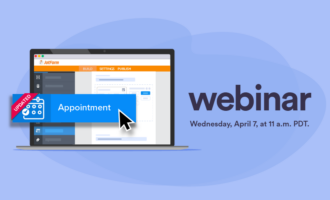Many factors go into a successful webinar, not least of which is timing. Research has found that people are most likely to participate in a live webinar on Wednesdays and Thursdays. But by using the following best practices, you can attract a webinar audience any day of the week.
If done correctly, webinars have huge potential as lead generation tools for businesses. A good webinar engages people and gives them strong reasons to take the next step in your marketing funnel. A boring webinar with no useful takeaways will send your audience running to your competitors.
In this post, we’re sharing nine tips for creating a webinar your audience will watch from beginning to end.
- Narrow your topic
- Create slides that bolster your presentation
- Don’t skimp on your equipment
- Do a test run with the webinar hosts
- Close out of all unnecessary apps and notifications
- Be ready early
- Don’t rush your presentation
- Set a stopping point
- Follow up
1. Narrow your topic
If you cover everything in your marketing webinar, there will be no next step for your prospect to take through the sales funnel. Select a narrow topic that answers a specific question, and you’ll entice viewers to seek more information.
A quality webinar that demonstrates your expertise succinctly is far more valuable than rambling speakers filling an afternoon with superficial talking points. The main thing is to stay focused.
2. Create slides that bolster your presentation
Your slide deck is not a script you read but a series of illustrations that add to what you’re saying. Interesting visuals include statistics, charts, and even screenshots. Carefully select visuals that illustrate your main points, support your authority on the topic, and keep your audience interested in what you’ll say next.
3. Don’t skimp on your equipment
A bad internet connection or poor-quality audio will make a bad impression regardless of the quality of your webinar’s content. The microphone on your laptop or mobile phone is inadequate for a professional webinar. Upgrading to a headset mic will resolve any problems with sound quality. Consider using a landline phone or ethernet cable when calling into the webinar to prevent any Wi-Fi connection issues.
Before recording the webinar, be certain all of the equipment is working properly. Make sure your laptop is charged, power cords are plugged in, the mic and camera are working, etc.
4. Do a test run with the webinar hosts
Conduct a test run with everyone who’ll be speaking during the webinar at least once before going live. Think of this as a dress rehearsal for a play. Have everyone run through the entire script so you can work out any problems before showtime.
A test run will reveal any equipment, audio, or connectivity problems. If there’s something off with the slide deck or talking points, these can be caught in the trial run and corrected before the actual webinar.
5. Close out of all unnecessary apps and notifications
Turn off any notifications on your computer. Receiving random Slack and email notifications will distract you and everyone watching your screen during the webinar. This could reveal confidential company information or, at the very least, make you look unprofessional.
Stay on the safe side, and close every app and tab that isn’t relevant to the webinar.
6. Be ready early
You want to be first on the call, so call at least 15 minutes early. If you wait until the start of your webinar to jump on the call, everyone who showed up before you will hear an obnoxious beep and wonder if something’s wrong with the webinar.
It’s OK to wait a couple of minutes to start the webinar to allow others to sign in, but waiting for more than five minutes to get started will annoy the people who are already there for the presentation.
A good practice for increasing webinar attendance is to send out email reminders the day before and again one hour before start time.
7. Don’t rush your presentation
If you rush through the webinar, you risk leaving your audience behind. There’s often a delay between when you make a change and when others see that change on their screens, so you should assume it will take five seconds before your guests see your changes.
8. Set a stopping point
Specify a fixed stopping point to let people know when the core material has come to a close. Keep the conversation going by answering user questions at the end.
9. Follow up
Send at least one follow-up email once your webinar is complete. This follow-up email should include a replay of the webinar as well as your desired call to action (CTA).
A quick follow-up will keep the material fresh in people’s minds and prompt them to act on your CTA.
Regardless of how well you prepare, something can still go wrong. Try not to stress over it. As you host more webinars, you’ll get more experience and learn what does and doesn’t work for your organization.







































































Send Comment: